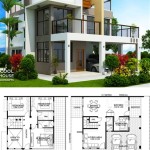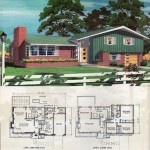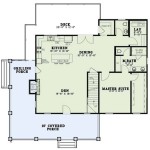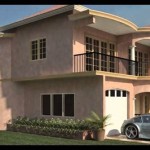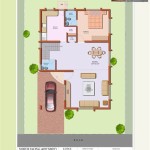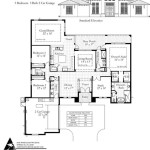2 Bedroom Small House Plans: Modern Design for Compact Living
The pursuit of comfortable and stylish living doesn't necessarily require expansive square footage. Modern 2-bedroom small house plans offer an excellent solution for individuals, couples, or small families seeking efficient and aesthetically pleasing living spaces. These plans prioritize smart design, maximizing functionality and creating a sense of spaciousness within a limited footprint. The modern aesthetic emphasizes clean lines, minimalist décor, and the incorporation of natural light, resulting in homes that are both practical and visually appealing.
The increasing cost of land and building materials makes small house plans a financially prudent option. Furthermore, smaller homes often translate to lower utility bills and reduced maintenance requirements, contributing to long-term cost savings. This article will explore key considerations when selecting modern 2-bedroom small house plans, highlighting essential design elements and offering insights into maximizing space and functionality.
Optimizing Space and Layout
The floor plan is the cornerstone of any successful small house design. In the context of a 2-bedroom layout, careful consideration must be given to the arrangement of spaces to ensure optimal flow and functionality. Open-concept living areas are a popular choice, combining the living room, dining area, and kitchen into a single, unified space. This approach eliminates walls and visually expands the perceived area, creating a more airy and inviting atmosphere.
Strategic placement of windows and doors is crucial for maximizing natural light and ventilation. Large windows or sliding glass doors, particularly in the living area and bedrooms, can significantly enhance the feeling of spaciousness and connect the interior with the outdoors. Consider incorporating skylights or clerestory windows to introduce natural light into areas that might otherwise be poorly lit. Careful attention should be paid to the prevailing wind direction and orientation of the house to promote natural ventilation and reduce the need for artificial cooling.
The bedrooms should be designed to provide privacy and comfort. A well-designed master bedroom should include adequate closet space and potentially an en-suite bathroom. The second bedroom can serve as a guest room, home office, or children's room. Incorporating built-in storage solutions, such as wardrobes or shelving units, can help to maximize space and minimize clutter in both bedrooms.
The kitchen design should prioritize efficiency and functionality. Compact appliances, such as a smaller refrigerator or a combination microwave oven, can help to save space. Consider incorporating vertical storage solutions, such as tall cabinets or open shelving, to maximize storage capacity. A well-designed kitchen island can serve as a focal point and provide additional counter space and seating.
Bathrooms in small houses should be designed with efficiency in mind. Wall-mounted toilets and sinks can save space and make the area feel less cramped. Consider incorporating a shower-tub combination to maximize functionality within a limited footprint. Ample storage is essential in bathrooms; consider incorporating built-in shelving or medicine cabinets to keep toiletries organized.
Modern Design Elements and Aesthetics
Modern design emphasizes clean lines, simplicity, and functionality. In the context of a small house, these principles are particularly important for creating a visually appealing and uncluttered space. A neutral color palette, such as white, gray, or beige, can create a sense of spaciousness and allow natural light to reflect throughout the interior. Accents of color can be introduced through furniture, artwork, or accessories.
Minimalist décor is a hallmark of modern design. Avoid clutter and excessive ornamentation. Choose furniture pieces that are both stylish and functional, and prioritize quality over quantity. Consider incorporating multi-functional furniture, such as a sofa bed or a coffee table with storage, to maximize space efficiency.
The use of natural materials, such as wood, stone, and glass, can add warmth and texture to a modern interior. Exposed brick walls, wood flooring, or stone countertops can create a sense of connection with the outdoors. Large windows and sliding glass doors further enhance this connection, blurring the boundaries between indoor and outdoor living spaces.
Pay attention to lighting design to create a comfortable and inviting atmosphere. Incorporate a combination of ambient, task, and accent lighting to provide adequate illumination and highlight specific features of the interior. Consider using energy-efficient LED lighting fixtures to reduce energy consumption and lower utility bills.
The exterior of the house should be equally well-designed. Simple, clean lines and a minimalist facade are characteristic of modern architecture. Consider using durable and low-maintenance materials, such as metal siding, concrete, or brick. A well-landscaped yard can enhance the curb appeal of the house and create a welcoming environment.
Maximizing Functionality and Storage
In a small house, effective storage solutions are paramount. Every available space should be utilized to minimize clutter and maximize functionality. Built-in storage is an excellent option, as it seamlessly integrates into the design and provides a customized storage solution.
Consider incorporating storage under stairs, in hallways, or behind furniture. Vertical storage solutions, such as tall cabinets and shelving units, are particularly effective in maximizing space utilization. Utilize wall-mounted shelves to keep floors clear and create a sense of spaciousness.
Multi-functional furniture is another key strategy for maximizing functionality in a small house. A sofa bed can serve as a comfortable seating area during the day and transform into a guest bed at night. A coffee table with storage can provide a convenient place to store books, magazines, or other items. A dining table with drop-leaf extensions can be expanded to accommodate additional guests when needed.
Pay attention to the organization of closets and storage areas. Utilize shelving, drawers, and hanging rods to maximize storage capacity and keep items organized. Consider using clear storage containers to easily identify the contents of each container. Regularly decluttering and getting rid of unnecessary items is essential for maintaining a clutter-free living space.
The use of smart home technology can also enhance functionality and convenience in a small house. Smart lighting systems can be programmed to automatically adjust the lighting levels based on the time of day or the occupancy of the room. Smart thermostats can help to regulate the temperature and reduce energy consumption. Smart security systems can provide added peace of mind.
In summary, modern 2-bedroom small house plans offer a compelling solution for individuals and families seeking comfortable, stylish, and affordable living spaces. By prioritizing smart design, optimizing space utilization, and incorporating modern aesthetics, it is possible to create a home that is both functional and visually appealing. Careful consideration of layout, lighting, storage, and materials is essential for maximizing the potential of a small house and creating a truly exceptional living experience.

Affordable Two Bedroom House Plan Guest Plans Small

Unique Small 2 Bedroom House Plans Cabin Cottage

2 Room House Plans Low Cost Bedroom Plan Nethouseplans

Pin On Granny Annexe

Plan 85165ms Modern 2 Bed House 1538 Sq Ft Plans Floor

Modern Style With 2 Bed 1 Bath House Plans Beautiful Bungalow

Contemporary Cabin House Plan 2 Bedroom 1200 Sq Ft Modern Plans

Two Bedroom Modern Style House With Interior Photos And Decors

40 More 2 Bedroom Home Floor Plans

Small House Design 4 60m X 8 00m 37 Sqm 2 Bedroom

